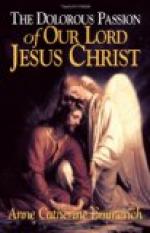5 She here again explained the manner in which the families assembled together, and in what numbers. But the writer has forgotten her words.
6 She was not certain that the Blessed Sacrament was administered in that order, for on another occasion she had seen John the last to receive.
7 It was not without surprise that the editor, some years after these things had been related by Sister Emmerich, read, in the Latin edition of the Roman Catechism (Mayence, Muller), in reference to the Sacrament of Confirmation, that, according to the tradition of the holy pope Fabian, Jesus taught his Apostles in what manner they were to prepare the Holy Chrism, after the institution of the Blessed Sacrament. The Pope says expressly, in the 54th paragraph of his Second Epistle to the Bishops of the East: ’Our predecessors received from the Apostles and delivered to us that our Saviour Jesus Christ, after having made the Last Supper with his Apostles and washed their feet, taught them how to prepare the Holy Chrism.’
8 On the 11th of December 1812, in her visions of the public life of Jesus, she saw our Lord permit the devils whom he had expelled from the men of Gergesa to enter into a herd of swine, she also saw, on this particular occasion that the possessed men first overturned a large vat filled with some fermented liquid.
9 Dulmen is a small town in Westphalia, where Sister Emmerich lived at this time.
10 Mary of Heli is often spoken of in this relation. According to Sister Emmerich, she was the daughter of St. Joachim and St. Anne, and was born nearly twenty years before the Blessed Virgin. She was not the child of promise, and is called Mary of Heli, by which she is distinguished from the other of the same name, because she was the daughter of Joachim, or Heliachim. Her husband bore the name of Cleophas, and her daughter that of Mary of Cleophas. This daughter was, however, older than her aunt, the Blessed Virgin, and had been married first to Alpheus, by whom she had three sons, afterwards the Apostles Simon, James the Less and Thaddeus. She had one son by her second husband, Sabat, and another called Simon, by her third husband, Jonas. Simon was afterwards Bishop of Jerusalem.
11 These meditations on the sufferings of Jesus filled Sister Emmerich with such feelings of compassion that she begged of God to allow her to suffer as he had done. She instantly became feverish and parched with thirst, and, by morning, was speechless from the contraction of her tongue and of her lips. She was in this state when her friend came to her in the morning, and she looked like a victim which had just been sacrificed. Those around succeeded, with some difficulty, in moistening her mouth with a little water, but it was long before she could give any further details concerning her meditations on the Passion.
12 The Zacharias here referred to was the father of John the Baptist, who was tortured and afterwards put to death by Herod, because he would not betray John into the hands of the tyrant. He was buried by his friends within the precincts of the Temple.




